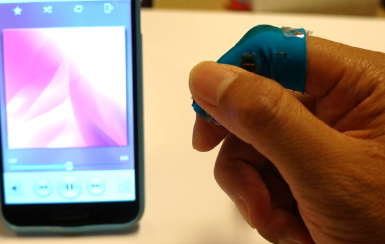Abstract: We introduce TIMMi, a textile input device for mobile interactions. TIMMi is worn on the index finger to provide a multimodal sensing input metaphor. The prototype is fabricated on a single layer of textile where the conductive silicone rubber is painted and the conductive threads are stitched. The sensing area comprises of three equally spaced dots and a separate wide line. Strain and pressure values are extracted from the line and three dots, respectively via voltage dividers. Regression analysis is performed to model the relationship between sensing values and finger pressure and bending. A multi-level thresholding is applied to capture different levels of finger bending and pressure. A temporal position tracking algorithm is implemented to capture the swipe gesture. In this preliminary study, we demonstrate TIMMi as a finger-worn input device with two applications: controlling music player and interacting with smartglasses.


